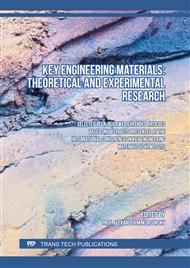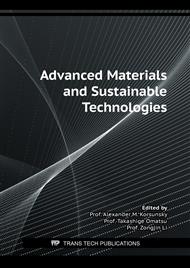[1]
N. M. Chalashkanov, S. J. Dodd, L. A. Dissado, and J. C. Fothergill, The role of bulk charge transport processes in electrical tree formation and breakdown mechanisms in epoxy resins,, IEEE Trans. Dielectr. Electr. Insul., vol. 23, no. 6, p.3256–3266, Dec. (2016).
DOI: 10.1109/tdei.2016.006141
Google Scholar
[2]
H. Zheng, S. M. Rowland, I. Iddrissu, and Z. Lv, Electrical treeing and reverse tree growth in an epoxy resin,, IEEE Trans. Dielectr. Electr. Insul., vol. 24, no. 6, p.3966–3973, Dec. (2017).
DOI: 10.1109/tdei.2017.006729
Google Scholar
[3]
Y. Wang et al., Electrical tree characteristics of epoxy resin under AC voltage at 77 K,, Cryogenics (Guildf)., vol. 99, p.123–129, Apr. (2019).
DOI: 10.1016/j.cryogenics.2019.04.005
Google Scholar
[4]
A. Li, C. Zhang, and Y. F. Zhang, Graphene nanosheets-filled epoxy composites prepared by a fast dispersion method,, J. Appl. Polym. Sci., vol. 134, no. 36, Sep. (2017).
DOI: 10.1002/app.45152
Google Scholar
[5]
S. Alapati and M. Joy Thomas, Influence of nano-fillers on electrical treeing in epoxy insulation,, IET Sci. Meas. Technol., vol. 6, no. 1, p.21–28, Jan. (2012).
DOI: 10.1049/iet-smt.2011.0046
Google Scholar
[6]
W. Yang, X. Yang, M. Xu, P. Luo, and X. Cao, The Effect of Nano SiO2 Additive on Electrical Tree Characteristics in Epoxy Resin,, p.683–686, (2013).
Google Scholar
[7]
X. Wang, Y. Zhao, K. Yang, S. Zhang, and Y. He, Effect of silane coupling agent modified alumina filler on breakdown characteristics of epoxy composites,, in in 2018 IEEE 2nd International Electrical and Energy Conference (CIEEC), p.544–547, Beijing, China, (2018).
DOI: 10.1109/cieec.2018.8745868
Google Scholar
[8]
H. Nguyen, A. Y. Mirza, W. Chen et al., Discharge resistant epoxy/clay nanocomposite for high torque density electrical propulsion,, in in 2018 IEEE Conference on Electrical Insulation and Dielectric Phenomena (CEIDP), p.171–174, Cancun, Mexico, (2018).
DOI: 10.1109/ceidp.2018.8544906
Google Scholar
[9]
J. J. Park, Electrical Treeing and Partial Discharge Characteristics of Epoxy/Silica Nanocomposite under Alternating Current,, Int. J. Polym. Sci., vol. 2021, (2021).
DOI: 10.1155/2021/6671681
Google Scholar
[10]
M. Bell et al., Investigation of dielectric breakdown in silica-epoxy nanocomposites using designed interfaces,, J. Colloid Interface Sci., vol. 495, p.130–139, Jun. (2017).
DOI: 10.1016/j.jcis.2017.02.001
Google Scholar
[11]
Z. Jing, C. Li, H. Zhao, G. Zhang, and B. Han, Doping Effect of Graphene Nanoplatelets on Electrical Insulation Properties of Polyethylene,, (2016).
Google Scholar
[12]
Z. Li, J. Su, B. Du, Z. Hou, and C. Han, Inhibition effect of graphene on space charge injection and accumulation in low-density polyethylene,, Nanomaterials, vol. 8, no. 11, Nov. (2018).
DOI: 10.3390/nano8110956
Google Scholar
[13]
T. Han et al., Inhibition effect of graphene nanoplatelets on electrical degradation in silicone rubber,, Polymers (Basel)., vol. 11, no. 6, Jun. (2019).
Google Scholar
[14]
M. Talaat, M. Tayseer, and A. El-Zein, Digital image processing for physical basis analysis of electrical failure forecasting in XLPE power cables based on field simulation using finite-element method,, IET Gener. Transm. Distrib., vol. 14, no. 26, p.6703–6714, Dec. (2020).
DOI: 10.1049/iet-gtd.2020.1176
Google Scholar
[15]
M. Talaat, M. Tayseer, and A. El-Zein, Digital image processing for physical basis analysis of electrical failure forecasting in XLPE power cables based on field simulation using finite-element method,, IET Gener. Transm. Distrib., vol. 14, no. 26, p.6703–6714, Dec. (2020).
DOI: 10.1049/iet-gtd.2020.1176
Google Scholar
[16]
A. Buketov et al., Investigation of thermophysical properties of epoxy nanocomposites,, Molecular Crystal and Liquid Crystal, vol. 628, no. 1, p.167–179, Mar. (2016).
Google Scholar



